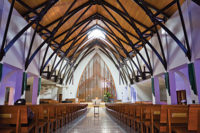Using 3-D Modeling


Estimator/Project Manager Tim Michaels, Foreman Mike Singleton, and Superintendent Mike Morgan.






Shake Shack started out as a hot dog cart in Madison Square Park in Manhattan. Clearly, the cart was quite the success considering the now restaurant chain just opened its first West Coast location in Las Vegas.
The owner of the project, MGM Grand Hotel and Casino in Las Vegas, envisioned a plan to create an outdoor paved public walk between two major hotels and a possible new NHL sports area—pending on the NHL’s vote on bringing a major league hockey team to the city.
Shake Shack was an integral part of this vision. The owner’s wanted to place a restaurant committed to incorporating sustainable design into each of its locations as an exterior-facing feature that helped to anchor the public space.
The Ceiling
Grani Installation Inc., the general contractor for the project, and Team Construction, the builder, used FSC-certified lumber and reclaimed wood from local bowling allies for the 9,135-square-foot restaurant project. The architect, Marnell Architecture, specified a versatile metal ceiling system from Hunter Douglas—the system is GreenGuard Gold certified and has the appearance of wood planking. The ceiling system’s versatile appearance allowed the manufacturer to produce a wood look for the interior ceiling to complement the FSC-certified wood products used throughout the restaurant design.
The flexibility to use the same product for the exterior ceiling application not only provided consistency through the design, but also helped keep the budget on track. One of the biggest obstacles during this design process was finding a slight curve in the ceiling—thanks to the use of 3-D modeling.
“Shake Shack started off as a normal project,” says Hunter Douglas’s Pre-Construction Manager Andrew Price. “Grani Installation asked for shop drawings and during that process by use of 3-D modeling we found something that didn’t seem right. The ceiling wasn’t a flat plane. We used BIM modeling to review this, took their layout and re-laid it out.”
The curves that were being induced interjected a seam across the ceiling plane. This slight “curve” in the design was coming across all light fixtures, and causing an unknown interference with the mechanical, engineering and plumbing trades.
“We had to coordinate with the HVAC and lighting trades,” Price says. “We were able to do all of this in a computer environment vs. change orders in the field. This is a typical scenario we’re finding when people adopt these 3-D softwares. You’re more able to find problems like these early on.”
Let’s Work Together
“Our initial shock was, ‘Wait, what do you mean the ceiling doesn’t fit?’” says Mike Morgan, building superintendent with Grani Installation. “All of the trades worked together to fix this. Andrew revised the shop drawings in just one day. It was amazing.”
“There were 15 elevation changes with the interior and exterior total,” Tim Michaels says, estimator and project manager with Grani Installation. “It’s a very time consuming and tedious process. You have to have patience with a project like this. It’s hard to do it right, it’s not easy.”
The job itself, according to Morgan, was a “moving target” to get it done in time. All of the trades worked together, and worked around each other to finish Shake Shack in the intended one-month timeframe.
“There were 30 to 40 people working at the same time in such a small place,” says Morgan. “There were guys doing exterior alongside guys putting in the glass and flooring. It was definitely crowded but everyone pitched in and everyone got along well.”
With a common goal in mind, each trade did what they could to ensure the project was completed within the tight project timeline, with only three weeks for the interior and one week for the exterior. This caused the various trades to really band together to see this come to fruition.
“Working through the issues in the ceiling, and working through the various avenues to help all parties involved understand our process, that’s what worked out best for us,” Price says.
Technology Leads the Way
Without a doubt, the use of 3-D modeling saved the day. Using this technology helped to find errors in a timely manner, and also allowed for a quick solution. The team mapped 15 different points across the various ceiling elevations to find the curve in the existing ceiling.
Due to the tight time frame, it was important that the project’s designers, contractors and manufacturer all worked together to explain the ceiling irregularities and create a plan to keep the project on schedule. Originally designed as a single-slope ceiling, the design was altered to a ceiling with two different planes. Not only are the two different slops aesthetically pleasing, but they also accommodate the irregularities in the ceiling found by 3-D modeling.
“Using an ‘internal BIM’, a 3-D model with various service items included, our team found conflicts that exposed mechanical, electrical and plumbing (MEP) issues in conjunction with the slopes and slope transitions of the ceiling design,” says Ron Rice, vice president of sales and marketing for Hunter Douglas Ceilings. “Hunter Douglas carried these issues to Grani Installation and the general contractor, who quickly involved the MEP trades to work with them to resolve problems found by 3-D modeling.”
“We used 3-D modeling to slice and dice the ceiling to understand what was going on and to find a solution,” Price adds.
Price went on to explain that the 3-D modeling really simplified the design process, versus 2-D methods. Getting contractors to be more aware of 3-D modeling, and using BIM more frequently is something Price hopes to see happen more often in the future.
The 3-D modeling provided the basis to determine the exact angle of each ceiling component manufactured. With this information, they were able to create custom-angled parts to fit in the inconsistent curvature of the ceiling—allowing the mechanical and lighting trades to make adjustments as necessary.
“It was encouraging that all parties were on the same page for the project,” Rice says. “Working with credible and understandable 3-D models brought all the different parties together to resolve these issues. It was necessary and very helpful.”
“The finished project is very impressive,” says Morgan. “It’s right on the strip. The exterior blows you away, even at night.”
What the Future Holds
Technology seems to be on the mind of every contractor, manufacturer and architect. It plays an integral role in the industry—and only promises to be more important in the future.
“We like to talk about MEP-F, where ‘F’ is the framer,” says Rice. “A key development we are seeing in the industry is the Division 9 contractors, the walls and ceilings guys, the 'framers' as we like to call them, are now becoming more involved in the 3-D environment. Bringing these guys to the table early on, along with the typical structural, MEP, and GC trades helps everyone out as so much relies on the building framing.”
The construction industry has grown beyond where it was prior to the recession. The use of software and tablets on the job site, and the importance of technology has changed a lot of mindsets in the field and pushed the industry to understand quality content in the building process—many thanks to the adoption of BIM.
“Since the recession the whole industry has grown exponentially,” Price adds. “Most people have consolidated and are beginning to recognize the importance of technology and using their specific skill sets.”
Job site Notes
- Project: Shake Shack, Las Vegas
- Owner: MGM Grand Hotel and Casino – Las Vegas
- Architect: Marnell Architecture
- General Contractor: Grani Installation Inc.
- Builder: Team Construction
- Manufacturer: Hunter Douglas
- Products: Woodwright Linear Plank Metal Ceiling System, Woodwright Box Series
Looking for a reprint of this article?
From high-res PDFs to custom plaques, order your copy today!










